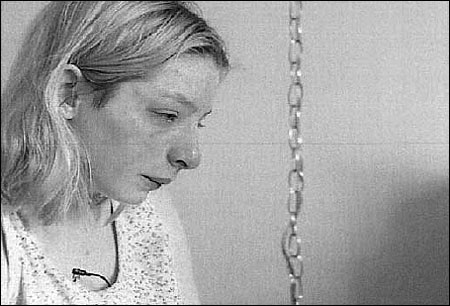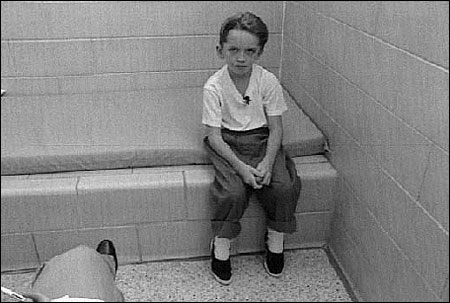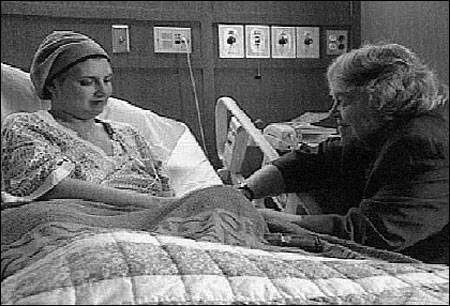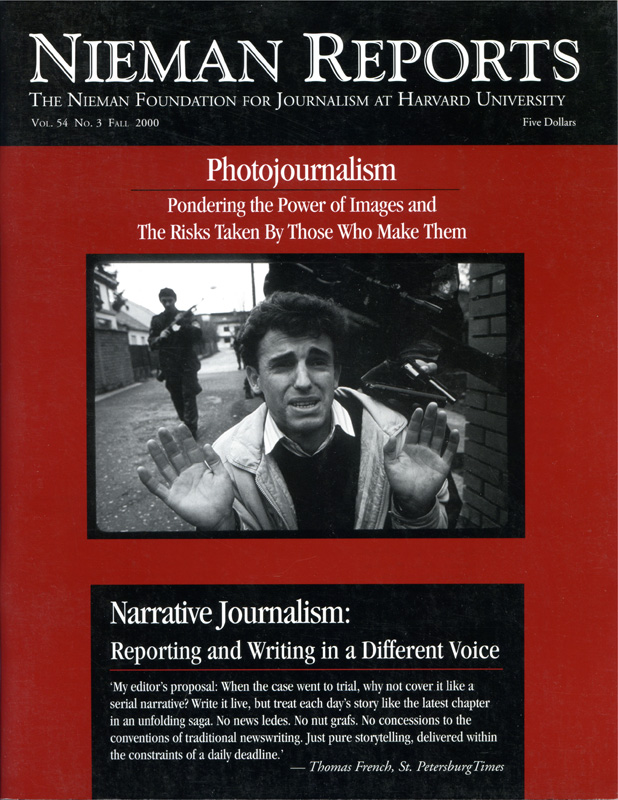

Videotape images capture the emotions of a pregnant 14-year-old and a young boy in detention. Courtesy of KPNX-TV.
It seems the goal of local television news is to get the story fast, tell it first, and be done in less than a minute. Some may wonder if there is any room for storytelling. Is the art of the narrative a thing of the past on television news? Eleven years and four local television stations later, I submit that the craft of storytelling is not dead. The challenges are greater, but so are the rewards.
I am a general assignment reporter at a local TV station in Houston, Texas. It is a news operation striving for balance between the fast-paced action of fires and drive-by shootings and the critical need for in-depth reporting about the community around us. I was hired six months ago with a resumé tape that showed no coverage of fires, murders or car accidents. The sample of my work included stories that demonstrated my strengths as a reporter—my ability to get close to subjects and people in ways that make the viewer want to take notice of their stories. Among those I selected for this tape was an in-depth report on a 14-yearold girl. She was a drug addict, newly pregnant, and trying to decide how to handle the challenges that were ahead.
Where do I find such stories? I found that one on the top of my husband’s dresser one fall afternoon. It was a crumpled-up piece of paper. It came from a student in his eighth-grade class. It read, “Dear Mr. Niezgoda, I just got back from the hospital after being treated for an overdose. I also found out I am 2 months pregnet. Well gotta go. Angie.”
That note was the beginning of a process in which I followed a 14-year-old recovering methamphetamine addict on her journey toward giving birth. Getting written consent from her mother was a challenge, but not as big of a challenge as getting my managers to allow me to follow her during the course of seven months. Remember this is “local” television news. I was told I could do it, but I would have to work around other daily assignments if I wanted to capture the critical moments I knew I needed. I would not be able to shadow this girl’s life as documentary reporters are able to do.
Nonetheless, I felt this was an important story to tell as a way to get at a lot of broader issues involving teenagers and sex and pregnancy, and believed that this approach was the way to tell it. Since Arizona—where I was then working at KPNX in Phoenix—has the highest rate of births to teens in the nation, I was convinced this was a story viewers would connect with. Yet given my position as a local TV reporter, I realized that I was about to take on a massive hit-and-miss project with the outcome unknown. Although this story was not going to go forward in precisely the way I wanted, I knew that I could connect with this 14-year-old and eventually be able to carry the process through. Such decision-making requires an inner confidence and, yes, a little bit of an ego.
Some shoots were scheduled during my normal workday. Those shoots were done when there were plenty of reporters available to cover the news of the day. On those days, I pitched my plans to the executive producer. My photographer and I then followed Angie at school, after school, and watched as she tried to convince her boyfriend and the father of her child to stay off drugs. But other shoots were done between my work on daily stories. My photographer and I squeezed in some shoots instead of taking a lunch break or after a five o’clock live shot on a daily story. We’d drive to Angie’s and capture whatever was going on at the time. Did we have to do it that way? No. We wanted to do it that way. We saw these compelling moments in her life and knew our audience would want to see them, too.
We also taped counseling sessions for pregnant teenagers and daycare centers at local high schools. In my narration, I was able to weave in facts about teen pregnancy and services that were available, even though Angie refused to participate in any of them. In fact, she dropped out of school and her boyfriend’s life became what defined her world. During this narrative piece, I told Angie’s story but I also told the story of what happens to so many young girls who find themselves in a situation like hers.
We were right about the powerful drama of this story. Angie’s last-minute decision not to give her baby to an adoptive family but to raise the child in poverty was an element that literally took our breath away. Two months later, Angie voiced those same emotions in front of our camera: “I don’t know where the diapers are going to come from. I had to use a washrag this morning.”
Our teen pregnancy hotline following the documentary lit up for hours after the segment aired. At each commercial break, we showed our hotline number and urged those who felt they needed help to call. Phones had been set up in our studios and were staffed by counselors and social workers during and after the broadcast. By the response we received, we knew Angie’s story had touched a nerve.
I used to think that good storytelling in local television happened only if a reporter was given a lot of time to do the story and a lot of time to tell it, as was the case in the story about Angie. But I have learned since then that is not always the case. When I set out to tell the story of several nine-year-old boys in a juvenile detention facility, I was able to work on the story for five days and still tell it in a narrative form. Much of the work during those five days involved negotiating with the facility’s managers to gain the kind of access we’d need to shoot the children’s faces. The negotiations were tough and we did not win on every point. But in the end we gained the access we needed to three boys, and their stories helped to move my reporting forward.
Ten thousand kids in Maricopa County, Arizona, walk through the doors of detention every year. An increasing number of them are eight and nine years old. I believed it was important to try to learn as much as we could from them about why this is happening. And then I wanted to explore what their stories tell us about the community we live in and the ways in which children are being raised and looked after. I have found that one important ingredient in narrative stories is taking viewers into places where they rarely go and giving them the ability to understand the experiences of those who are there. When this story was aired on our 10 o’clock news broadcast, it shocked quite a few of our viewers who had no idea little white, blonde-haired, blue-eyed boys were being locked up in a little room night after night, sometimes for months on end.
We called the piece “The Littlest Suspects.” It was not told in a minute. Instead, the station allocated four minutes. Once the station managers saw the rough cut of the story, they recognized the power of the piece they were about to air. I no longer had to fight for time to tell the story; the story, itself, earned the extra minutes.
I’ve also come to understand that how much time a reporter is given to tell the story is not the critical issue. What is most important is having a character whose story and presence is compelling enough to take viewers to these places they have never been so they can see things in ways they haven’t seen them before. I was in Houston three months before I met Sister Alice Potts. She is a chaplain at the world-renowned M.D. Anderson Cancer Center. Instead of doing a series of on-camera interviews with colleagues and patients who could tell me how great she and the work she does are, I had the camera follow Sister Alice. That’s all. At 75 years old, she’s been a chaplain at the hospital for more than a quarter of a century. Her spunk, her style, her outlook on cancer, definitely provided a story worth telling.
I shot the Sister Alice story in one day. It aired the same night that a shooting and a fire and a lot of other bad news appeared in our newscast. The piece came on after the first commercial break. In my opinion, it was a much-needed breather from the dismal way in which the other news portrayed the city that night.
Great stories are told when reporters find the right people. It is through their eyes and experiences that the best stories are told and remembered. Finding such voices and fitting their words into a broader context of understanding doesn’t happen standing in front of the emergency room doing a live shot for the 10 o’clock news. It happens when a reporter goes behind the emergency room doors and reaches the people who work on the other side. It might not be a story for that night’s broadcast. But it might become an unforgettable story for some night in the future.
In the changing media environment, local television news is confronting many new challenges. Being a reporter in the newsroom, I don’t know every detail of what our industry is facing. But I think I do know something about what people like watching.
It seems ironic to me that the audiences who often complain about negative coverage are the same ones who are seemingly drawn to the murder-of-the-day approach to telling the news. I realize ratings cannot be maintained without doing what it takes to pull in that core audience, but I suggest that local news stations strive for a balance.
Weaving words and pictures together is something television relies on. Yet, too often what gets put on local newscasts are pictures of disastrous events, selected because of the emotional punch the images deliver and ease by which they can be gathered. Words often seem to be irrelevant, sort of interchangeable except for the location each night. Sadly, one fire story blends in with the next, when in reality there are very different and compelling stories to tell, stories about people and what will happen to them now. This kind of reporting takes longer, requires creativeness and perseverance, but in the end gives us, as reporters, greater satisfaction and gives our viewers the kind of news coverage they will long remember.

Videotape image of Sister Alice Potts with patient. Courtesy of KHOU-TV.
Carolyn Mungo currently works as a reporter for KHOU, the CBS station in Houston. A nine-time Emmy award-winner, she has twice been honored with a World Medal by the International New York Festivals.


